The Earth's climate is always changing. It shifts through a regular cycle of temperatures. These cycles last around 100,000 years. They move the Earth through warm periods, then cold ones. This is known as climate oscillation.
Right now, we are in a warm period called an interglacial period. Cold periods are known as ice ages. This natural cycle has happened for millions of years. But it has been changed by humans. This human-led change is called Climate Change.

A big effect of climate change is the rise in global temperature. Humans have released greenhouse gases into the atmosphere (read more about the Greenhouse effect below). As greenhouse gases rise, so do the average temperatures on Earth. Not all areas on Earth will experience climate change in the same way.
Some areas will become much warmer. Others will become colder. Higher temperatures cause glaciers to melt. When they melt, more freshwater ends up in the ocean. This contributes to sea-level rise and changes crucial processes in the ocean.
One of these processes is the Gulf Stream. The Gulf Stream brings warm water from the Southern Hemisphere to the UK. If the Gulf Stream becomes weaker, the UK will become colder. Sea-level rise means some coastal areas will disappear underwater. The weather will become more extreme too. This leads to more storms and flooding.
These changes to the environment will have an effect on all life. Some species will become extinct. There are many more impacts of climate change. Climate scientists are working hard to understand them. But there are things we can all do to help tackle climate change.
Some actions are simple, like not wasting energy. We can move to renewable energy sources, like solar and wind power. Wind and solar power reduce the amount of fossil fuels we burn. Fossil fuels like oil and gas release greenhouse gases. We can use energy-saving light bulbs in our homes. We can turn our heating down by a degree. Small changes can help. But we also need countries to work together. To make a big difference, we need global agreements.

- The Greenhouse Effect
The Greenhouse Effect on Earth:
A greenhouse works by allowing the heat from the Sun to go straight in through its glass windows. Once inside, this heat energy is trapped by the glass. This makes the greenhouse get hotter.
You can see this in more detail in the following stages.
Stage 1: Solar Energy
The yellow arrow shows the direction of heat radiation from the Sun. The Suns heat is warming the greenhouse.
Image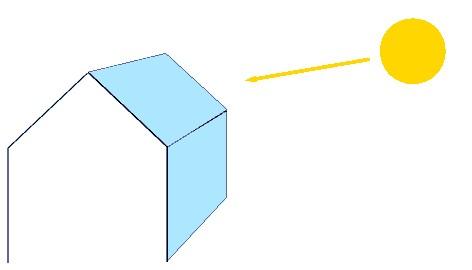 CreditThis work by The Schools' Observatory is licensed under All rights reserved
CreditThis work by The Schools' Observatory is licensed under All rights reservedStage 2: The Sun's energy enters the Greenhouse
Because the Sun is so hot, the heat radiation can pass through the glass roof of the greenhouse.
Image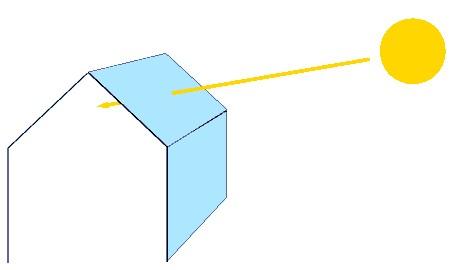 CreditThis work by The Schools' Observatory is licensed under All rights reserved
CreditThis work by The Schools' Observatory is licensed under All rights reservedStage 3: The Sun's energy is absorbed and re-radiated
The inside of the greenhouse absorbs the Sun's radiation and heats up. The greenhouse then produces radiation of its own.
Image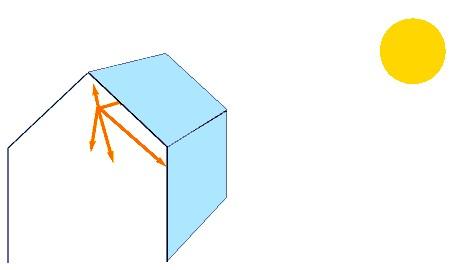 CreditThis work by The Schools' Observatory is licensed under All rights reserved
CreditThis work by The Schools' Observatory is licensed under All rights reservedStage 4: The re-radiated energy is trapped
The inside of the greenhouse is much cooler than the surface of the Sun, so it produces a different type of light. This is called infra-red light. It does not pass through the glass as easily. Thus, the heat gets trapped
Image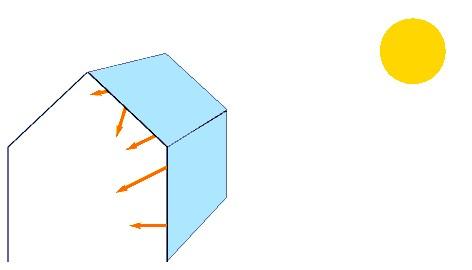 CreditThis work by The Schools' Observatory is licensed under All rights reserved
CreditThis work by The Schools' Observatory is licensed under All rights reservedA similar thing can happen to some planets. Instead of glass, some gases in the atmosphere can trap the Sun's heat energy. These gases stop the heat from escaping back into space. These gases are known as Greenhouse Gases. The more of them there are in the atmosphere, the stronger the greenhouse effect is.
There are three main Greenhouse Gases on Earth. They are methane, water vapour, and carbon dioxide (CO2). They occur naturally, but humans can raise their levels.
- Methane is produced when plants decompose. It is also produced by rice and cattle farming, and coal mining.
- Water vapour is produced when water from oceans and lakes evaporates. It is also produced by burning some fuels.
- CO2 is produced when plants and animals respire. It is also produced during forest fires and volcanoes. A lot of CO2 is produced when we burn fossil fuels or make cement. Sometimes humans cut down forests to clear the land for farming. When we do this, we stop those trees from removing CO2 from the atmosphere. This means more CO2 ends up in the atmosphere.
If the amount of greenhouse gases increases, so does the average temperature on Earth. This leads to climate change. One effect of climate change is the melting of polar ice.
Image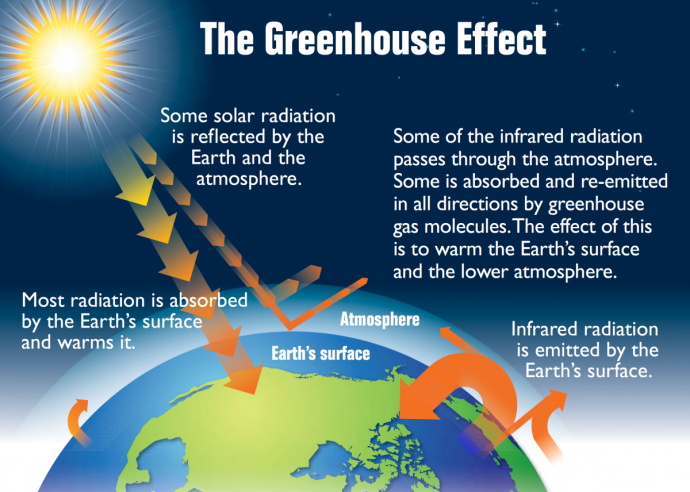 CreditThis work by US Environmental Protection Agency is licensed under Creative Commons Zero v1.0 Universal
CreditThis work by US Environmental Protection Agency is licensed under Creative Commons Zero v1.0 UniversalThe Greenhouse Effect on Earth The Greenhouse Effect on Venus:
Venus has a much stronger greenhouse effect than Earth. The temperature on Venus is around 400°C higher than on Earth. The greenhouse effect makes the surface of Venus even hotter than the surface of Mercury. Although Mercury is closer to the Sun.
